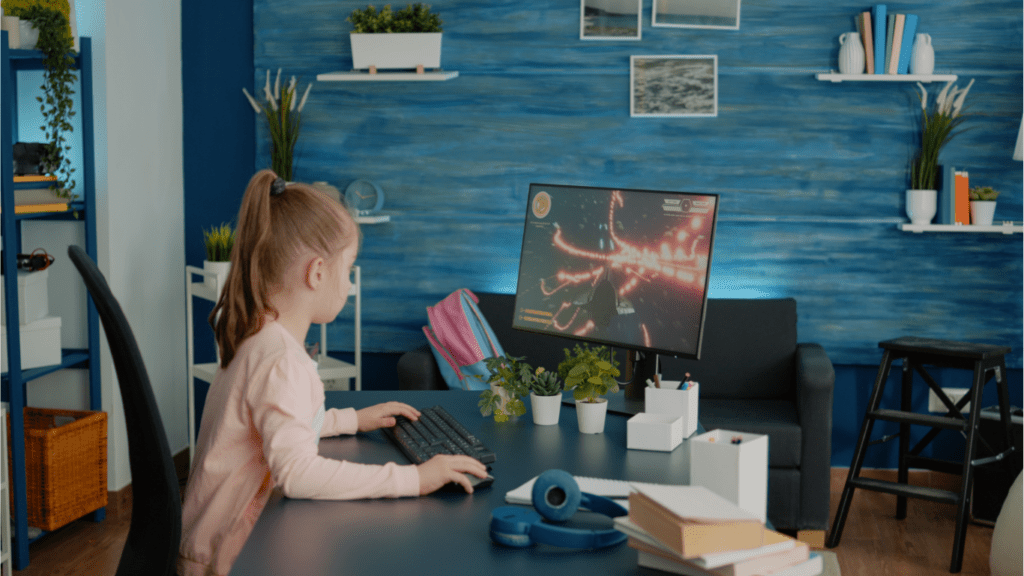Understanding the Basics of Environmental Design
What Is Environmental Design?
Environmental design merges art and science to create spaces that captivate and engage users.
It involves strategizing and organizing physical elements to craft organic, functional settings that convey specific emotions or storytelling elements.
Within video games, virtual reality, or themed attractions, this discipline ensures that every visual detail contributes to the user’s immersive experience.
Key Principles of Immersive Worlds
1. Cohesion and Consistency: Successful environments maintain a harmonious style throughout. Uniform textures, color palettes, and architectural details ensure that elements feel part of a single connected world. For example, medieval-themed settings might use stone textures, muted colors, and gothic architectural elements to maintain consistency.
2. Attention to Detail: Every environment needs detailed elements to be convincing. Small objects, like scattered tools in a workshop or fallen leaves in a forest, enhance realism. These details create a lived-in feel, making the space believable.
3. Interaction and Feedback: Incorporating interactive elements engages users more deeply. Movable objects, reactive lighting, and sound effects make the environment responsive. When a user picks up an object or steps on a surface, immediate feedback through audio or visual cues enhances immersion.
4. Lighting: Effective lighting sets the mood and directs the user’s focus. Natural lighting can create calm, open spaces, while focused, dramatic lighting can build tension. For instance, dim lighting in a horror game heightens suspense and guides players’ attention to critical areas.
5. Spatial Awareness and Navigation: Designing for ease of movement is crucial for immersion. Clear pathways, landmarks, and intuitive layouts prevent users from feeling lost. For example, themed parks often use prominent structures to guide visitors seamlessly through the experience.
These principles serve as essential components in creating engaging and immersive environments, providing users with a seamless and memorable experience.
Important Elements of Immersive Environmental Design
1. Spatial Composition and Layout
Spatial composition and layout determine how users interact with environments. Designers organize spaces to guide movement, create focal points, and convey a sense of place.
Effective use of space maximizes functionality while enriching the user experience. By establishing clear pathways and designated areas, environments can evoke emotions or develop a narrative.
Leveraging positive and negative space ensures balance and harmony, promoting immersion.
2. Use of Color and Light
Color and light significantly impact mood and perception. Designers utilize color palettes to evoke specific feelings or themes.
Warm colors like red and orange stimulate excitement, while cool colors like blue and green foster calmness.
Lighting techniques enhance these effects by casting shadows, highlighting features, and simulating different times of day.
Dynamic lighting, like flickering lights or changing hues, adds realism and draws users into the environment.
3. Integrating Textures and Details
Textures and details contribute to the believability of an environment. Surfaces like stone walls, wooden floors, or metal fixtures anchor users in the setting.
The inclusion of small details, such as cracks, wear marks, and other imperfections, adds depth.
These features not only create visual interest but also offer tactile cues that users can imagine touching, thereby enhancing the experience.
Technological Tools and Software for Environmental Design
Real-Time Rendering Engines
Real-time rendering engines create a dynamic visual environment.
These engines, like Unreal Engine and Unity, enable designers to see changes immediately.
Working with these engines, I can manipulate lighting, textures, and geometry to achieve a realistic look without waiting for long rendering times.
Unreal Engine supports advanced features, including photorealistic visuals through ray tracing.
Its Blueprints visual scripting system allows for quick iterations. Unity, known for its versatility, provides a responsive design environment suitable across multiple platforms.
Advanced 3D Modeling Software
Advanced 3D modeling software forms the backbone of intricate environmental design.
Applications such as Autodesk Maya and Blender allow for precise modeling and texturing.
For instance, using Maya, I can craft detailed environments with its robust toolset. Its integration with other Autodesk products ensures a seamless workflow from concept to final model.
Blender, an open-source alternative, offers both modeling and rendering capabilities in one package. The software’s extensive plugin ecosystem and community support provide tools to enhance productivity and creativity.
With these tools, effective environmental design becomes a more streamlined and efficient process.
Expert Tips for Successful Environmental Design
Learning from Industry Leaders
I study industry leaders to gain insights into successful design strategies. Renowned designers often share their knowledge through interviews, conferences, or publications. For example, Hideo Kojima’s intricate world-building in games like Death Stranding offers valuable lessons in environmental storytelling. Similarly, Disney Imagineers’ approach to creating themed attractions showcases the importance of detail and visitor engagement. Analyzing these experts’ work enhances my design skills and inspires innovative ideas.
Incorporating Natural Elements Effectively
Natural elements add authenticity to any environment. I incorporate realistic vegetation, water features, and geological formations to create immersive worlds. For example, the lush forests in The Legend of Zelda: Breath of the Wild use various plant species and natural lighting to enhance realism. I also consider the interplay between these elements and user interaction. Incorporating responsive foliage that moves with wind or user presence makes environments more dynamic and believable.
Balancing Aesthetics with Functionality
Striking a balance between aesthetics and functionality ensures both visual appeal and user-friendly navigation. I design spaces that are aesthetically pleasing but also intuitive to navigate. For instance, I use clear landmarks and lighting cues to guide users through complex environments. In games like Dark Souls, strategic level design directs players without breaking immersion. Functional design elements like pathways, seating areas, and interactive objects contribute to a coherent and engaging user experience.
Case Studies: Examples of Successful Immersive Worlds
Video Games

- Video game environments offer some of the most detailed and intricate examples of immersive worlds.
- Titles like “The Witcher 3: Wild Hunt,” “Red Dead Redemption 2,” and “The Legend of Zelda: Breath of the Wild” showcase expertly crafted worlds.
- “The Witcher 3” uses meticulous world-building, diverse landscapes, and rich lore to create an engaging experience. Players encounter dynamic weather systems, day-night cycles, and interactive elements that make the world feel alive.
- In “Red Dead Redemption 2,” Rockstar Games achieved realism through detailed textures, realistic lighting, and lifelike animal behavior. Every part of the environment, from bustling towns to open prairies, was designed to enhance the narrative. NPCs (non-playable characters) follow daily routines, adding another layer of authenticity.
- “The Legend of Zelda: Breath of the Wild” breaks traditional game design with its open-world format. It emphasizes exploration and experimentation, letting players interact with the environment in various ways.
The game balances vast landscapes with intricate details, providing a sense of wonder and discovery.
Virtual Reality Experiences
Virtual Reality (VR) has revolutionized immersive world design.
“Half-Life: Alyx,” “The Climb,” and “Star Wars: Vader Immortal” stand out as prime examples.
“Half-Life: Alyx” utilizes VR to bring players into a tactile, interactive environment. The game’s use of detailed textures, spatial audio, and physical interactions creates a highly immersive experience.
“The Climb,” developed by Crytek, focuses on the thrill of rock climbing.
The game uses photorealistic graphics and precise physics to simulate the experience of scaling cliffs. This level of detail helps players feel the height, effort, and scenery as if they were climbing in real life.
“Star Wars: Vader Immortal” leverages the iconic “Star Wars” universe to immerse players.
The experience combines narrative-driven gameplay with interactive environments, utilizing VR to make the player feel part of the story. Detailed visual and auditory elements enhance the overall immersion.
These video game and VR case studies highlight the importance of detail, interactivity, and realism in creating compelling immersive worlds.


 Charlie Bracegirdle seamlessly combines his passion for gaming with his role at Infinity Game Saga, where he is both a dedicated gamer and a prominent content creator. As an integral member of the team, Charlie brings a wealth of experience and a deep understanding of the gaming industry to his work. His articles and content cover a broad spectrum of gaming topics, from detailed reviews and insightful industry analyses to the latest trends and upcoming releases.
Charlie’s unique perspective, shaped by his own extensive gaming experiences, allows him to engage with readers in a meaningful way. His writing not only informs but also entertains, providing a blend of professional insight and personal enthusiasm. Whether he's exploring new game mechanics, dissecting game strategies, or sharing his thoughts on the future of gaming, Charlie's contributions make a significant impact on the Infinity Game Saga community. Through his work, he bridges the gap between gamers and the evolving landscape of the gaming world, enhancing the experience for all who follow his updates and analyses.
Charlie Bracegirdle seamlessly combines his passion for gaming with his role at Infinity Game Saga, where he is both a dedicated gamer and a prominent content creator. As an integral member of the team, Charlie brings a wealth of experience and a deep understanding of the gaming industry to his work. His articles and content cover a broad spectrum of gaming topics, from detailed reviews and insightful industry analyses to the latest trends and upcoming releases.
Charlie’s unique perspective, shaped by his own extensive gaming experiences, allows him to engage with readers in a meaningful way. His writing not only informs but also entertains, providing a blend of professional insight and personal enthusiasm. Whether he's exploring new game mechanics, dissecting game strategies, or sharing his thoughts on the future of gaming, Charlie's contributions make a significant impact on the Infinity Game Saga community. Through his work, he bridges the gap between gamers and the evolving landscape of the gaming world, enhancing the experience for all who follow his updates and analyses.
